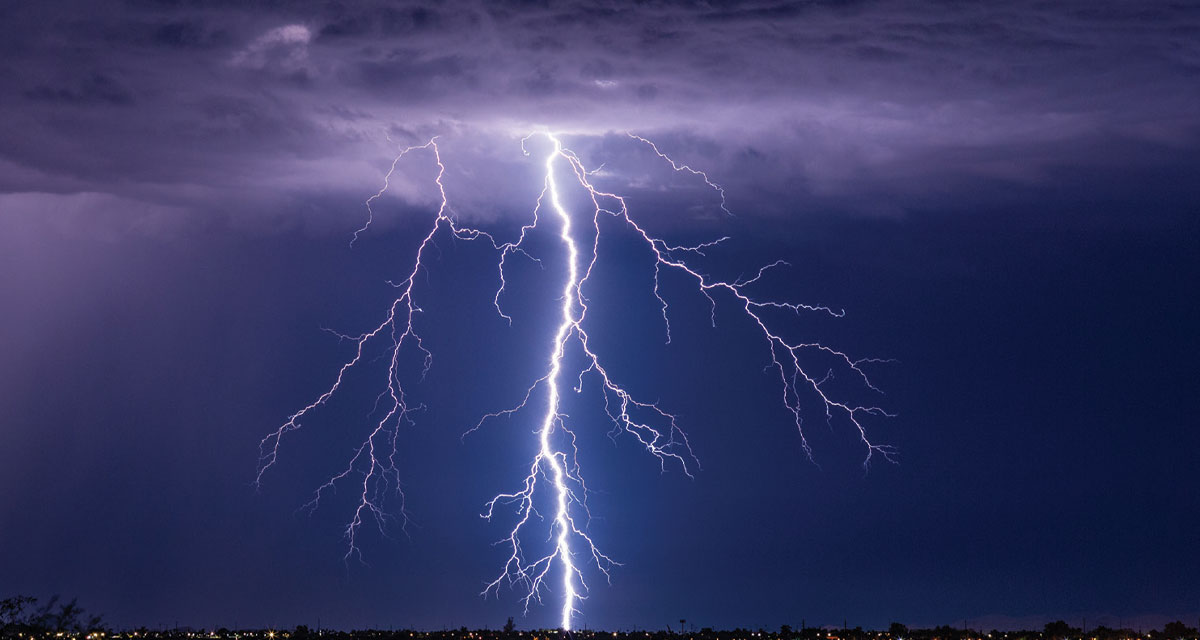At any moment, about 2,000 thunderstorms are occurring worldwide…but what causes thunderstorms?
A thunderstorm needs three things in order to form – moisture, unstable air and a lift.
Moisture: For a thunderstorm to develop, there must be an adequate amount of moisture in the lower levels of the atmosphere. This moisture is necessary to form clouds and precipitation.
Unstable Air: An unstable air mass is characterized by warm air at the surface that is cooler higher up. This instability can be caused by warm air existing underneath much colder air.
Lift: Something must lift the warm, moist air to allow it to rise. This can be due to the landscape, such as mountains, or it can be due to the sun’s heat causing the ground to warm up and the warm air to rise.
The summer heat means more moisture in the air which is prime time for thunderstorms in most parts of the U.S., though thunderstorms can happen any time of year.
So, what about lightning? Lightning causes thunder!
In a thunderstorm, lightning happens when an electrical event occurs within or between clouds or between a cloud and the ground.
Although thunder and lightning occur simultaneously, you see lightning before you hear thunder because the speed of light is much faster than the speed of sound. If you are very close to a lightning strike, you see lightning, hear the sound of the electrical event, and then both hear and feel the booming shockwave of the thunder.
And, what should we know about thunder?
Thunder is the sound of the shockwave produced by the rapid heating and expansion of air, followed by cooling and flowing into the vacuum formed by the expansion. The shockwave resembles that of an explosion.
Thunder is loud. Close to its source, it is about 165 to 180 decibels, although it can exceed 200 decibels.
If you listen carefully, there are different types of thunder:
Claps or Thunderclaps: Claps are very loud, last between 0.2 and 2 seconds, and contain higher pitches of sound.
Peals: A peal of thunder changes irregularly in loudness and pitch.
Roll: A roll of thunder has a regular variation of loudness and pitch.
Rumbles: Rumbles are low pitch and not very loud, but they last a long time (up to 30 seconds).
A few different factors play into the sound of thunder, including the presence or absence of a temperature inversion and whether the thunder comes from the first lightning strike (louder) or return strokes (quieter).
Understanding the Storm
The time between seeing lightning and hearing thunder gives a good estimate of how far away you are from the lightning strike. Use some simple math to figure it out. Count the number of seconds between seeing lightning and hearing thunder, then divide this number by five, and you have an approximate distance in miles to the lightning strike.
Keeping Safe in a Thunderstorm
Although the odds of being struck by lightning each year are less than one in a million, some factors can put you at greater risk. Lightning most often strikes people who work outside or engage in outdoor recreational activities. Regional and seasonal differences can also affect your risk of being injured by lightning.
In 2022, Florida had the most lightning deaths. Florida is considered the “lightning capital” of the country, with more than 2,000 lightning injuries over the past 50 years.
The consequences of lightning strikes are serious. From 2006 through 2022, lightning caused an average of 27 deaths per year in the United States.
Staying safe during a thunderstorm involves taking immediate action to minimize the risk of being struck by lightning or affected by other storm-related dangers.
Here are the key safety measures to follow:
Find Shelter: Seek a substantial building or a car with a metal roof and sides as shelter. Avoid trees, small structures and open areas.
Stay Indoors: Remain inside until the storm passes, and stay away from windows and doors.
Avoid Electrical Devices: Do not use landline phones or any devices connected to electrical outlets and stay away from plumbing.
Prepare for Secondary Risks: Be aware of potential flooding, power outages and other hazards that may follow a thunderstorm.
Thunderstorms can be beautiful, peaceful and even relaxing if you understand them, respect their power and take the necessary measures to keep yourself protected.



















